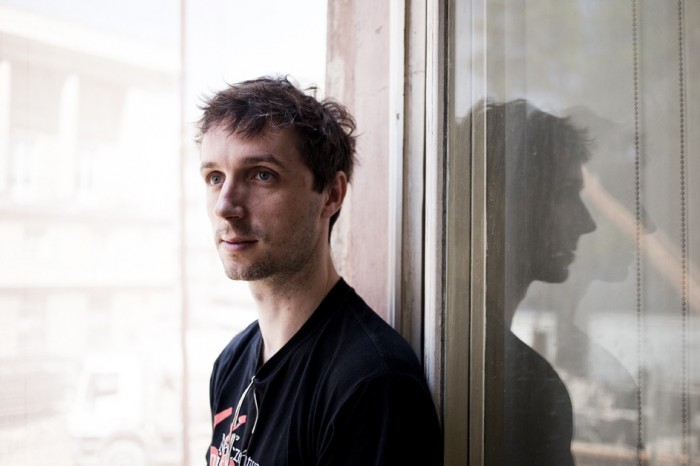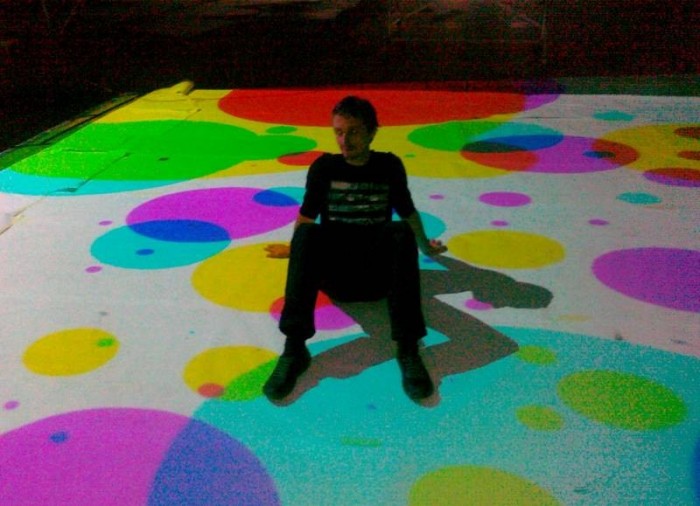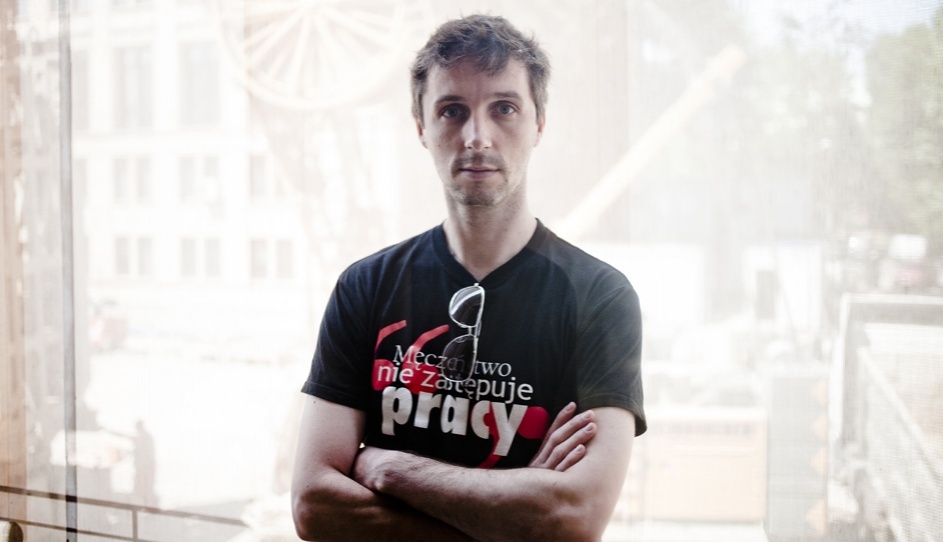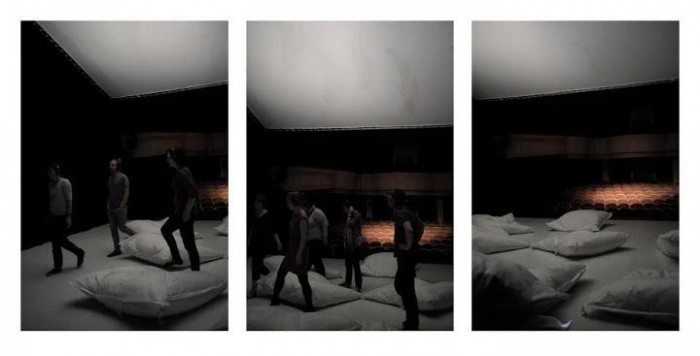AREK GRUSZCZYŃSKI: Let’s start with hard facts. Why did you decide to leave for Lisbon?
WOJTEK ZIEMILSKI: I was 25 and just about to graduate from a French university with a degree in philosophy. I left for Portugal mostly due to relationship trouble, but fear of coming back to Poland also played a part – I had no idea what I would do here. My family thought I lacked a plan for the future and that I decided to start over in some new corner of the globe. Only my Dad broke ranks and said that even if that idea ends up a failure, I’ll still gain some new, unique experiences. As it turned out, Portugal turned my life around. Some of my closest friends are there, and the theatre experiences I had over there have greatly influenced the way I express myself creatively even though Portuguese theatre itself doesn’t have an illustrious tradition and its artistic qualities are, frankly speaking, quite low.
Wojtek Ziemilski
Wojtek Ziemilski, born 1977, is a theatre director and visual artist. His works balance on the borders of various disciplines: theatre, visual arts, choreography. Graduate of the Gulbenkian Foundation in Lisbon. For a period of time he lived in Portugal, where he created, among other pieces, a multimedia performance Hamlet Light. Upon returning to Poland he cooperated with TR Warszawa. He conducts workshops on experimental forms in theatre. Author of performances: Mała narracja (2010), Mapa (2010), Prolog (2011). His performance / installation Pokrewni premiered at this year’s Malta Festival in Poznań. He writes a blog on contemporary art new-art.blogspot.com (in English) and collaborates with BWA Warszawa gallery.
Dance theatre, however, is far from stagnation. In the 1980s, a group of dance artists from Lisbon decided to travel abroad in search of modern performance art. They were fed up with lack of access to bold, interesting artistic endeavors. They studied, interned at important cultural institutions, and worked hard to gain knowledge and establish a network of contacts in the world of dance and theatre. Later they returned to Lisbon, invited the artists they met abroad to perform there and thus redefined the Portuguese capital’s cultural landscape. They focused on workshops and festivals. The artists who came to Lisbon back then quickly established themselves at the forefront of the artistic dance world. When I arrived in Lisbon in 2000, their students and collaborators have branched out and formed their own groups, they were curators, and actively involved in culture.
While in Lisbon you were awarded the Gulbenkian Foundation scholarship.
Yeah, it was a course in direction with the Brits from Third Angel. We met for a few months, there was twelve of us plus one teacher, Alexander Kelly. Kelly was able to create a space where we could practice live art, that is performance art combining theatre and visual arts. It was all based on two elements – the relationship between the theatre and the outside world and implements of collective action. Our goal was to engage the whole group in the preparation of a show or a particular event. We learned how to move from brainstorming to action. We created improvisations that could be later expanded into entire plays. And finally, we also acquired the ability to relieve the director of his power. For example, we split into two smaller groups. The first group served as the audience, while the people from the other group were the performers. After the exercise was over, the “audience” met with the director and relayed to him all the observation they made during the performance, which the director, in turn, relayed to the actors. Suddenly, it became apparent that the director served as speaker for the audience which gained agency in the process. The director no longer was the almighty master of the stage.
Your shows combine choreography, visual arts and theatre. What is the result of such a mixture?
In itself it yields no results. It’s terribly naive to think that simply combining video arts with dance will create something new and original. Even if we were to add rabbits on stage and get a painter to paint the entire play on a canvas – it would definitely be something new, but it would never ever convince me. Even worse, it would have absolutely no effect on the audience. We use certain means for a reason. When it comes to choreography, the means should be directly related to the quality of the search, to the particular variation on the theme of theatre.
Modern choreography unceremoniously operates – often without even resorting to dance – amid a slew of subjects, such as limits of personal identity, its relationship with the community – and extrapolating, with society, the politics of a collision, understood as gathering a particular group of bodies on stage, as well as confronting the people in the audience with who’s performing right in front them. There are dance performances consisting only of people talking, drawing, or just standing around. Choreography isn’t attractive to me just because somebody’s dancing, but because it enables us to see people we’ve already seen dancing before they were in the throes of theatrical choreography from a completely new perspective. Plus, there’s this amazing innocence that accompanies our perception of people who we see “on stage”.
 photo: Krzysiek Krzysztofiak / krzysiekrzysztofiak.com
photo: Krzysiek Krzysztofiak / krzysiekrzysztofiak.com
We perceive it as something completely natural. Is that naturalness in any way threatened by multimedia?
Well, multimedia seem very natural to me. I use multimedia techniques simply because they are available. I use them every single day, so I don’t see any reason why I refrain from using them in theatre or visual arts. The situation with multimedia resembles the period in our history when mechanical watches were no longer considered “peculiar feats of engineering” and became natural parts of our everyday lives. Multimedia are also directly linked with a particular way of experiencing the world around us, they are a part of us. For example, my body has already adapted to handling cell phones.
You’re a victim of phantom phone vibrations?
Sure! Sometimes I am so damn sure that the phone vibrated that it makes me feel like I’m going insane. It’s really terrible.
Most of your experience with theatre comes from working in Lisbon but you’re developing your own theatre here, in a Polish context. How does that influence your creative output?
I’ve had a lengthy discussion once with Joanna Warsza on that exact subject. After we made Mała narracja (Small Narrative), which did not contain any overt references to Poland, Joanna mentioned that not running away from our current environs as well as our roots should be important to theatre itself. She noticed that the story we were trying to tell in that project was not only my story, but it was also a Polish story. It was kind of similar with Poor Theatre: Remix which we made for Commune//Warsaw, and which required me to process a selection of writings by Stanisław Wyspiański. I think that embracing this radical approach that forces us to work within a single context and acting from a single perspective is an unnecessary act of self-censorship. If we were to follow that train of thought, we might end up asking ourselves about the underlying sense of plays written by Americans or the French, which themselves do not contain any references to these countries or cultures. They can, for example, tell us about the worries of globalisation, about love or history. I feel that my travels removed any trace of the “ours”/”theirs” dichotomy from my life and work. I don’t have the need to constantly remind everyone that I’m from Poland.
Total neutrality is a myth, of course. Some time ago, back in Portugal, I created a play together with a group of students; to me it seemed to be a universal study of identity. After the performance, an older man came up to me and said: “Well, this was Polish to the core!” My Polish identity surely bubbles up to the surface without any conscious effort on my part: in my approach to light, to malleability of form, to the dramatisation of given situations. For example, it’s difficult for me to create an informal setting in a play. I guess the root of this problem lies within the Polish tradition of thinking using form and light; I can’t just escape what I soaked up in my youth. It’s also the result of this local perception of the artwork itself.
You’re talking about building situations on stage?
I’m talking about the situation of the audience, which for me is the basic starting point. Do people feel like they’ve just seen a “work of art” when they leave the theatre? Do they witness something complete, something finished? Or quite the contrary, do we leave a space for the audience to work out the play on its own terms? As part of an audience myself, I prefer the latter. I really like when the authors of the play have enough confidence in my ability to interpret certain issues and they leave their work, their characters, and their stories open. Meanwhile, when assuming the role of director, it’s hard for me at times to construct the play in a way that leaves space for the viewer to frolic in. Many of my own projects were about this particular difficulty. The viewer knows that he’s forcefully inserted into a certain situation, that I’m not willing to let him go just yet. But sometimes, when I manage to do things right, this space of independence springs up on its own. The issue is shrouded in a certain ambivalence. Seeing my plays on stage and their reception can be pretty hard for me. It’s torture, probably because I cannot accept that I have to surrender complete control over my creation.
Some people have called you a “performer”.
It’s a very suspect word. I only use it to distinguish between people who show up in my plays and actors in that narrower sense – the latter understood as people who play a given part. The performer’s task is to find himself in multiple different circumstances. It’s directly related with translating words and actions into tangible reality. What is symbolic, or abstract, can result in true change. If that happens, the performer becomes an effective creator of reality.
Other people call you a “director”.
Dirty words, all of them. When people ask me who I am, I say them I’m a director because they tend to leave me in peace. The Polish word for “director” has some very bad connotations for me, personally. The director is, first and foremost, a demiurge. He’s also an egocentric, a good dad, and somebody who has all the power because he’s so invested in his own suffering. In Poland, the Konrad motif, the theme of somebody carrying the burdens of the whole universe on their shoulders, applies to most directors. Reżyser, “director” in Polish, comes from the French word régisseur, which translates into “stage director” or “someone who arranges things” if we’re looking for a more direct translation. In our theatre, this person who “arranges things” comes from a wholly different world – a messenger of a metaphysical order suffused with religious faith. Polish thinking still suffers from equating spectacle with religious ritual, thus making the director a member of the priesthood. We love sacrum. When we lost our last game of the 2012 Euro championships, our commentators kept talking about faith and hope. If even professional sports are ruled by metaphysics, then it must be even worse with theatre.
I prefer a director who’s an organiser, who makes decisions in the moment, when there’s a lot going on – ideas being thrown in from all sides, the team is united in a joint effort, and later a single person makes a decision. The director has one additional vote, but that doesn’t allow him to leverage the process. The director should be an inquisitive listener. In Great Britain, there’s something called group direction.
How does that work?
The entire group directs the play. Everybody gets to sit in the director’s chair. In a group made up of a handful of people, everyone has a vote and only decisions that were made together are later put into effect.
That must be really hard.
Terribly so.
I just imagined five people like Krystian Lupa working together on a play.
Now reverse that perspective. Imagine Lupa and his actors caught up in the moment, when the director does not speak or only has a limited number of words he can say, as do other in the group. Later, everyone casts a vote and there has to be unanimity. You can’t just let one person lead the rest. What is the effect of such collaboration? I can already hear people muttering in unison: the biggest piece of shit, the introduction of the most basic democracy and populism results in nobody really knowing anything and a general lowering of the bar. Meanwhile, in reality something completely opposite might happen. The results of such collaborations are not always convincing for me, but they surely present some new possibilities. I employ these methods in particular situations. When faced with such modus operandi, people stop operating according to a predetermined set of rules. Radical and fantastic ideas are born on the crossroads.
 Prolog rehearsal, Soho Factory
Prolog rehearsal, Soho Factory
What does it look like when you’re heading a project?
During the first month of rehearsals for Prologue, we sat at a table and wrote the play together. Thanks to Google Docs we were all working on the same document in real time. We were all writing simultaneously! When a new fragment appeared, everyone had to adjust accordingly. The changes were often significant. We were stuck for a bit when we wrote the introduction. I tried to lead but later refused to speak for two days, and when I opened my mouth it was to complain. Finally, Sean Palmer, one of the co-creators (as we decided to call the two performers) got mad and started writing. Suddenly, we had a basis of the entire first part, and 80% of that made it into the final draft. This spontaneous fit of writing completely changed the situation of the audience: the viewers already participated in the play even before they sat in their chairs.
It’s hard to remember who came up with what back then. But when Sean started working on the material, he came up with one of the crucial elements of the entire puzzle. Of course, there were situations where I absolutely refused to change anything. But we’ve been collaborating for a long time in a form of direct democracy, at first on screen and later on stage.
You once said that experimenting in theatre does not necessarily translate into quality, although experiments are accompanied by a peculiar energy. What did you mean by that?
Curiosity, and not experimentation, should be the starting point. I’m curious, what’s just around the corner? Maybe I’ll decide to build a temporary house out there? And suddenly, this unknown fragment of reality becomes the most important one. Currently, I’m working on a project called Pokrewni (Relatives), a story of a reunion of a very extensive Asian family. This material is different from the writings of Wyspiański, and thus the experience of the project will be very different. In both of these cases, the play is about community and legacy, but my position is radically different from the position the audience is in. In this particular instance, the experiment lies in discovering ourselves in different places. All of this is very hit-and-miss, for example, we wanted to conduct interviews for this project and we thought that it won’t be a problem, that the interviewed people will be very much into it – but it didn’t happen and everything went downhill. Such nasty surprises can be very stimulating, but they can lead to very sorry results. I value artists who can find inspiration in such failures, I feel that their bravery rubs off on me. That, in turn, allows me to get tangled up in new messes, again and again.
You also host workshops. How do they tie in with your projects? Is it always the same workshop?
Yeah, we’re only changing the names [laughs]. These exercises are often based on a formal understanding of a play, on choreography games, and on creating very strict rules that allow us to build plays the way some sculptors approach installations – they discover what the installation should be in the process of sculpting.
All of this might sound very peculiar. Is it easy for you to connect with people participating in the workshops?
I think that everything that I find appealing in art is received very well in Poland. People enjoy documentary theatre, like the Rimini Protokoll, Gob Squad, Public Movement, or the extensive, multi-hour narratives of Forced Entertainment. Despite that, basically nobody is involved with that type of performance here. There are times when I feel like a weirdo, a “curious case” so to speak. In this particular type of art, collaboration with other people involved in similar activities is absolutely crucial. It’s about creating an environment. I’m running workshops, organising conferences and seminar in the hope that at least a few of the participants will get mad and say: “Ziemilski’s showing some interesting things, but he has no idea what to do with it, we need to do it in a different way.” If a curious person gets angry, there’s a chance we might do some good stuff together.
Where does Ziemilski fit in the overall map of the Polish theatre? Most people try to place you with the alternative crow.
I’m in the mainstream. Look around – nowadays even ads for shoes are often bolder than the so-called alternative. There’s no point in deluding yourself. And it’s not a small niche either: contrary to what the artists and critics are saying, there are a lot of people in Poland that are currently looking for new experiences, who want art to be bold. This desire is neither alternative, strange, nor unattainable. My goal is to create a situation, where my work would establish itself as an obvious part of the cultural landscape and as valid in the eyes of my peers. Luckily, we’re moving away from thinking that there’s only one mainstream and multiple “offs”, so to speak. We’re discovering that there are multiple mainstreams, and the “off” is just one blink away from the mainstream. In Germany, we have the urban bourgeois theatre, the “magnificent director” theatre, and right beside them, often under one roof, we have dozens of bold projects, all of them recognised by both audiences and critics. In Poland, we’re still locked in a war for the souls of the people. It’s about having enough diversity to fill different spaces and avenues of theatre and performance art. I’m a very impatient man. I’m not going to sit around and wait for a different theatre to come, I’m going to start doing it myself.
translated by Jan Szelągiewicz














